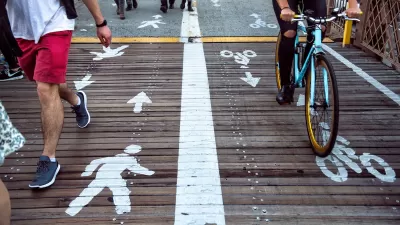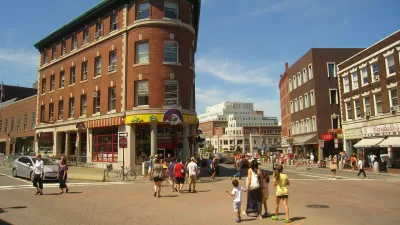Based on empirical study, J. Alexander Maxwell and fellow University of Strathclyde researchers, in collaboration with Chuck Wolfe, argue for recalling historic patterns of pedestrian city settings in contemporary urban design and policies.

In a recent study, J. Alexander Maxwell and fellow researchers from the University of Strathclyde’s Urban Design Studies Unit in Glasgow found evidence that before the rise of the automobile, cities developed on a walkable “human” scale, with main streets that rarely exceeded 400 meters (a little more than 437 yards) (the "400-m rule"). Along with Chuck Wolfe, they argue that this uniformity reveals an underlying pattern to pedestrian city settings, which should be considered in contemporary urban design and policies.
They note:
Some elements of our urban environments change relatively quickly over time. New shops replace old shops, new buildings replace old buildings, and people come and go. However, other elements are more permanent and often reflect the planning policies, design paradigms, and technologies of the times when they were built. In a sense, these surviving features provide snapshots of our urban histories.
Among their preliminary explorations was a test of the 400-m rule against 100 historically diverse main street networks from cities in 30 different countries around the world. Figures illustrate historic cases, including main street networks from groupings of ancient, medieval, renaissance, baroque, and industrial study areas. Post-industrial cases included main street networks from groupings of Garden City, Radiant City, New Urbanism, and informal settlement patterns of development.
The results of this empirical study suggest that the observational claims behind the 400-m rule are in fact true.
The authors opine that the uniformity of the findings suggests an "effortless" expression of human tendencies – a signature that should be honored by policy and design consistent with this established norm.
Their conclusion illustrates typologies of liveable communities that attempt results that are very similar to the 400-m rule, and provides a call to action:
[M]ore conscious study is needed to tie together past and present. If underlying patterns of human-scale design in urban settings can be captured from historic environments and reapplied in contemporary policy and implementation contexts, then new purpose can be realized from past realities.
FULL STORY: City main street networks show a drastic shift away from historic patterns of human-scale design

Planetizen Federal Action Tracker
A weekly monitor of how Trump’s orders and actions are impacting planners and planning in America.

Congressman Proposes Bill to Rename DC Metro “Trump Train”
The Make Autorail Great Again Act would withhold federal funding to the system until the Washington Metropolitan Area Transit Authority (WMATA), rebrands as the Washington Metropolitan Authority for Greater Access (WMAGA).

The Simple Legislative Tool Transforming Vacant Downtowns
In California, Michigan and Georgia, an easy win is bringing dollars — and delight — back to city centers.

The States Losing Rural Delivery Rooms at an Alarming Pace
In some states, as few as 9% of rural hospitals still deliver babies. As a result, rising pre-term births, no adequate pre-term care and harrowing close calls are a growing reality.

The Small South Asian Republic Going all in on EVs
Thanks to one simple policy change less than five years ago, 65% of new cars in this Himalayan country are now electric.

DC Backpedals on Bike Lane Protection, Swaps Barriers for Paint
Citing aesthetic concerns, the city is removing the concrete barriers and flexposts that once separated Arizona Avenue cyclists from motor vehicles.
Urban Design for Planners 1: Software Tools
This six-course series explores essential urban design concepts using open source software and equips planners with the tools they need to participate fully in the urban design process.
Planning for Universal Design
Learn the tools for implementing Universal Design in planning regulations.
Smith Gee Studio
City of Charlotte
City of Camden Redevelopment Agency
City of Astoria
Transportation Research & Education Center (TREC) at Portland State University
US High Speed Rail Association
City of Camden Redevelopment Agency
Municipality of Princeton (NJ)





























